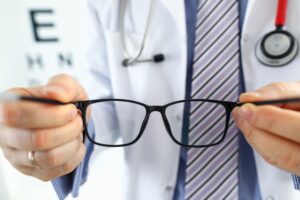Intervertebral hernia – a disease caused by the rupture of the fibrous ring in the intervertebral disc, and out of the nucleus. For a better understanding of this disease should be noted that the intervertebral disc is a cartilaginous body connecting the vertebrae together. Intervertebral disk performs damping function due to the presence in the structure of the nucleus pulposus and low compressibility, limited fibrous ring. It is due to rupture of the fibrous ring and intervertebral hernia occurs because of the pressure created by the nucleus pulposus comes out, forming a protrusion, which is most often localized in the spinal canal.
Types of herniated
In size can be divided intervertebral hernia:
- Prolapse – hernia protrusion of 2-3 mm,
- Protrusion – bulging hernia from 4 to 15 mm,
- Extrusion – loss abroad nucleus of the intervertebral disc.
Distinguish 4 stage clinical manifestation of intervertebral hernia:
- Stage I – cracks in the intervertebral disk herniation results in the formation of up to 2-3 mm. At the first stage the nucleus pulposus protrudes, the circulation of this zone is violated, there is swelling of local tissue, adhesions, hypoxia roots of the spinal cord.
- Stage II – there are protrusions (4-15 mm). In the cervical and thoracic spine sharp pains have dull in nature, due to irritation of the posterior longitudinal ligament arises referred pain in the arm and leg. Appears compression radicular syndrome caused tension and mechanical compression of the spine.
- Stage III – formed osteophytes, impeded blood flow, there is a partial atrophy of the nerve root, the core of the disc almost ceases to perform its function of depreciation.
- Stage IV – constant pain leads to atrophy of surrounding tissues, pain in the spine and joints disappear. This causes wrinkling and the seal of the intervertebral disc, calcining, zero mobility of vertebral-motor joint.
By location intervertebral hernia divided into:
- sidepiece
- anterolateral
- posterolateral
- median (foraminal)
- combined
Causes of intervertebral hernia
Predisposition for herniated discs may be due to the structural features of the spine, which are inherited, insufficient development of the muscular system, infectious diseases, improper posture, low back pain and so on. Called intervertebral hernia in sharp movements, excessive exercise, injuries, sharp turns of the trunk and other negative factors.
The symptoms of herniated
Symptoms may vary depending on the place of origin of herniated discs. This disease is characterized by pain, numbness, tingling, weight loss of one hand or feet, muscle weakness, or other phenomena.
In case of herniated discs in the lumbar spine, the pain will spread from the waist up, the pain intensity over time will increase. Because of the pain constrained motion in the lumbar spine, it is impossible to walk normally. Progression of the disease leads to a malfunction of the internal organs and cause other symptoms.
At the beginning of the disease there is a pain in the lumbar region. At some point, the presence of spinal herniation of the lumbar spine begins to show itself by unpleasant sensations in the leg. Very often, because of the unbearable pain impossible to move normally. If in time is not seeking treatment for spinal herniation, there are violations of the internal organs, lameness and restrictions on movement.
In the case of hernia of the cervical spine, is the spread of pain in the arm, a headache, restriction of mobility of the cervical spine, the neck muscles can lose their symmetry.
Intervertebral hernia of the thoracic spine leads to pain in the chest, which can be during inhalation and exhalation, in some patients it is perceived as heartache. However, in the thoracic spine herniated discs occur rarely.
Diagnostics
For the diagnosis of a herniated disc should be properly collected complaints of the patient to determine the nature of pain, body position, in which there is pain, rule out other diseases. Then it is necessary to carry out tests to check muscle strength, reflexes, and declining violate this disease. After roughly defined plot location herniated appointed additional studies, which include magnetic resonance imaging, computed tomography, x-ray.
All additional inspections may be carried out only by the physician and the patient, if desired, in some cases, they are necessary to eliminate the anomalies of the spine or other diseases.
To select the correct treatment strategy is very important to diagnosis the main causes of back pain.
Treatment of herniated
Treatment of herniated possible in two ways: operative or conservative. Generally, treatment is initiated with the use of conservative techniques. This solves the main tasks aimed at relief of pain, reduction of edema, as well as full restoration of function of the spine, muscle strength and sensitivity areas that were hit. Non-surgical treatment involves the use of active reflex techniques such as acupuncture, vacuum therapy, pharmacopuncture and others.
By operating methods try to be resorted to only in cases where conservative ineffective. During the operation, either partially or completely removed the modified portion of the intervertebral disc.
The best results in the treatment of herniated discs are achieved by combining the reflex therapies such as acupuncture, vacuum therapy, moxibustion, pharmacopuncture, et al. Timing of treatment in this disease are generally from 2-3 weeks to 5-6 months. If the treatment does not improve the state during this period of time, in this case deciding about the advisability of surgical treatment intervertebral hernia.
In clinical practice, there are the following most common treatment of herniated : Generic Motrin (Ibuprofen), Generic Indocin (Indomethacin), Generic Mobic (Meloxicam), Generic Naprosyn (Naproxen), Generic Dexone (Dexamethasone) and others (which you can buy online through the Internet that will cost you cheap or with good discounts).





